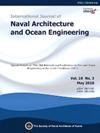依赖附件尺寸的双螺旋水面战斗舰的水平面航向稳定性和机动
IF 3.9
3区 工程技术
Q2 ENGINEERING, MARINE
International Journal of Naval Architecture and Ocean Engineering
Pub Date : 2025-01-01
DOI:10.1016/j.ijnaoe.2025.100655
引用次数: 0
摘要
本文通过拖曳坦克自备模型试验,对双螺杆水面作战舰艇“滚落之家”(ONR tumblehome, ONRT)的动力性能和机动性能进行了评估,并采用系统仿真技术研究了附件尺寸对其航向稳定性和机动性能的影响。首先,在韩国船舶海洋工程研究院(KRISO)的拖曳舱中,在弗劳德数高达0.4的情况下进行阻力和推进试验,以便在本仿真模型中考虑其全尺寸动力性能。特别是,船体产生的波浪模式对剩余阻力有显著影响。其次,进行了水平平面运动机构(HPMM)试验,得到了浪涌、摇摆和偏航方向的水动力系数。采用三自由度模块化模型,仿真了转向和之字形机动,并与已有的基准自由运行模型试验进行了验证。为了评估定舵ONRT整船的直线稳定性,建立了横摆耦合线性全船模型。将线性水动力系数分解为船体和附属物两部分,以便更详细地分析附属物尺寸对船舶操纵性能的影响。当舵面积增大或减小时,在直线稳定性相同的约束条件下,重新设计了系数和中心线偏差的位置。针对一艘原舰和两艘改进型舰,采用线性全船模型对转弯和之字形操纵进行了仿真。尽管直线稳定性相同,但随着舵面积的增加,转弯直径减小,而之字形超调角增大。为了保证这种双螺杆船有足够的操纵性,在设计中线舵和舵时应特别注意。本文章由计算机程序翻译,如有差异,请以英文原文为准。
Horizontal plane course-stability and manoeuvres of a twin-screw surface combatant depending on appendage dimensions
In this study, powering and manoeuvring performance of a twin-screw surface combatant, ONR tumblehome (ONRT), are estimated through towing tank captive model tests, and influences of appendage dimensions on its course-stabilities and manoeuvres are investigated by system-based simulation techniques. At first, resistance and propulsion tests are carried out at Froude numbers up to 0.4 in the towing tank of Korea Research Institute of Ships and Ocean Engineering (KRISO) so that its full-scale powering performance can be considered in the present simulation model. In particular, the residuary resistance is significantly affected by patterns of hull generated waves. Secondly, horizontal planar motion mechanism (HPMM) tests are performed to derive hydrodynamic coefficients in surge, sway, and yaw directions. By using 3-DoF modular-type models, turn and zig-zag manoeuvres are simulated, and simulations are validated with existing benchmark free-run model tests. Sway-yaw coupled linear whole ship models are also established in order to assess a straight-line stability of a rudder-fixed ONRT whole ship. Linear hydrodynamic coefficients are decomposed into hull and appendage components so that influences of appendage dimensions on ship manoeuvres can be analyzed in more detail. When the rudder area is enlarged or reduced, the coefficient and the location of a centerline skeg are redesigned under the constraint straight-line stabilities are identical. For one original ONRT and two modified ships, turn and zig-zag manoeuvres are simulated by linear whole ship models. Even though straight-line stabilities are identical, the turning diameter is decreased while zig-zag overshoot angles are increased with increasing rudder area. To ensure sufficient manoeuvrabilities of such a twin-screw ship, careful attentions should be paid to design of a centerline skeg and rudders.
求助全文
通过发布文献求助,成功后即可免费获取论文全文。
去求助
来源期刊

International Journal of Naval Architecture and Ocean Engineering
ENGINEERING, MARINE-
CiteScore
4.90
自引率
4.50%
发文量
62
审稿时长
12 months
期刊介绍:
International Journal of Naval Architecture and Ocean Engineering provides a forum for engineers and scientists from a wide range of disciplines to present and discuss various phenomena in the utilization and preservation of ocean environment. Without being limited by the traditional categorization, it is encouraged to present advanced technology development and scientific research, as long as they are aimed for more and better human engagement with ocean environment. Topics include, but not limited to: marine hydrodynamics; structural mechanics; marine propulsion system; design methodology & practice; production technology; system dynamics & control; marine equipment technology; materials science; underwater acoustics; ocean remote sensing; and information technology related to ship and marine systems; ocean energy systems; marine environmental engineering; maritime safety engineering; polar & arctic engineering; coastal & port engineering; subsea engineering; and specialized watercraft engineering.
 求助内容:
求助内容: 应助结果提醒方式:
应助结果提醒方式:


